History > MARK SCHEMES > GCE History A Y314/01: The challenge of German nationalism 1789-1919 Advanced GCE Mark Scheme for No (All)
GCE History A Y314/01: The challenge of German nationalism 1789-1919 Advanced GCE Mark Scheme for November 2020
Document Content and Description Below
GCE History A Y314/01: The challenge of German nationalism 1789-1919 Advanced GCE Mark Scheme for November 2020 Oxford Cambridge and RSA Examinations GCE History A Y314/01: The challenge of Germ... an nationalism 1789-1919 Advanced GCE Mark Scheme for November 2020Oxford Cambridge and RSA Examinations OCR (Oxford Cambridge and RSA) is a leading UK awarding body, providing a wide range of qualifications to meet the needs of candidates of all ages and abilities. OCR qualifications include AS/A Levels, Diplomas, GCSEs, Cambridge Nationals, Cambridge Technicals, Functional Skills, Key Skills, Entry Level qualifications, NVQs and vocational qualifications in areas such as IT, business, languages, teaching/training, administration and secretarial skills. It is also responsible for developing new specifications to meet national requirements and the needs of students and teachers. OCR is a not-for-profit organisation; any surplus made is invested back into the establishment to help towards the development of qualifications and support, which keep pace with the changing needs of today’s society. This mark scheme is published as an aid to teachers and students, to indicate the requirements of the examination. It shows the basis on which marks were awarded by examiners. It does not indicate the details of the discussions which took place at an examiners’ meeting before marking commenced. All examiners are instructed that alternative correct answers and unexpected approaches in candidates’ scripts must be given marks that fairly reflect the relevant knowledge and skills demonstrated. Mark schemes should be read in conjunction with the published question papers and the report on the examination. © OCR 2020Y314/01 Mark Scheme November 2020 2 Annotations Annotation Meaning of annotation Blank Page Highlight Off-page comment Assertion Analysis Evaluation Explanation Factor Illustrates/Describes Irrelevant, a significant amount of material that does not answer the question Judgement Knowledge and understanding Provenance Simple comment Unclear View Synthesis Continuity/ChangeY314/01 Mark Scheme November 2020 3 Subject Specific Marking Instructions Section A Question Answer Mark Guidance 1 Evaluate the interpretations in both of the two passages and explain which you think is more convincing as an explanation of the role of Wilhelm II in the government of Germany. • In locating the Interpretations within the wider historical debate, answer might argue that Interpretation A puts forward the view that the Kaiser played a limited role in government. • In evaluating Interpretation A, answers might argue that this view is valid as Wilhelm’s social and ceremonial duties meant that he was often absent from Berlin. • Answers might argue that Interpretation A is valid as Wilhelm’s behaviour was liable to wild fluctuations. • Answers might argue that Wilhelm played a key role in the development of the fleet as he was jealous of the British fleet. • Answers might argue that Interpretation A is not valid as the Kaiser had extensive powers and could appoint and dismiss the Chancellor. • Answers might argue that Interpretation A is not valid as he believed that he was accountable to God alone and ‘there is only one ruler in the Reich and I am he’. • In locating the Interpretations within the wider historical debate, answers might argue that Interpretation B puts forward the view that the Kaiser played a significant role in government. 30 • No set answer is expected • At Level 5 and above answers will evaluate both interpretations, locating them within the wider historical debate about the issue and using their own knowledge, and reach a balanced judgement as to which they consider the most convincing about the issue in the question. • To be valid, judgements must be supported by relevant and accurate material. • Knowledge must not be credited in isolation, it should only be credited where it is used to analyse and evaluate the interpretations, in line with descriptions in the levels mark schemeY314/01 Mark Scheme November 2020 4 2* • In evaluating Interpretation B, answers might argue it is valid as no decisions could be made without his approval. • Answers might argue that Interpretation B is valid as Wilhelm did dismiss Bismarck. • Answers might argue that Interpretation B is valid as Chancellors after Bismarck were expected to show loyalty to the Kaiser if they were to survive. • Answers might argue that Interpretation B is valid as the Kaiser interfered in foreign affairs such as the Moroccan crisis. • Answers might argue that Interpretation B is not valid as he did not have command of detail of the government’s work. • Answers might argue that Interpretation B is invalid as state occasions, military manoeuvres, cruises and hunting trips meant he was often away. To what extent did the aims of German nationalism change in the period from 1789 to 1919? • In arguing that the aims of German nationalism did change, it might be argued that under Wilhelm II nationalism became more aggressive and expansionist. • Answers might consider that the aims changed from the economic dominance of Prussia to the political. • Answers might consider the cultural nature of early German nationalism which appealed to the middle class changed to a more popular nationalism later. 25 • No set answer is expected • At higher levels answers might establish criteria against which to judge • To be valid, judgements must be supported by relevant and accurate material. • Knowledge must not be credited in isolation, it should only be credited where it is used as the basis for analysis and evaluation, in line with descriptions in the levels mark scheme.Y314/01 Mark Scheme November 2020 5 3* • Answers might consider the growth of radical nationalism. • Answers might consider the growth of popular organisations, such as the Navy League. • Answers might consider the development of Pan-Germanism in the later part of the period. • Answers might consider that political unity was not an initial aim. • In arguing that the aims of German nationalism did not change, it might be argued that Prussia dominated throughout and it was the Prussianisation of Germany that emerged. • Answers might consider that the suppression of France remained a constant aim. • Answers might consider the continued debate over Klein and Gross deutsch. • Answers might consider that war and militarism played an important role throughout. • Answers might consider that economic development was an aim throughout. ‘The accession of Kaiser Wilhelm II in 1888 was the most important turning point in the development of German nationalism during the period from 1789 to 1919.’ How far do you agree with this view? • In supporting the hypothesis that it was the most important turning point, it might be argued that it led to a more radical nationalism. • Answers might consider the development and growth of Pan-Germanism. • Answers might consider the development of aggressive and expansionist nationalism that led to the First World War. 25 • No set answer is expected • At higher levels answers might establish criteria against which to judge • To be valid, judgements must be supported by relevant and accurate material. • Knowledge must not be credited in isolation, it should only be credited where it is used as the basis for analysis and evaluation, in line with descriptions in the levels mark scheme.Y314/01 Mark Scheme November 2020 6 4* • Answers might consider the role played by the Kaiser in developing nationalism with his involvement. • Answers might consider the growth in nationalist pressure groups. • Answers might consider the increased role of the Kaiser in government and its impact on nationalism. • Answers might consider the development of popular nationalism. • In challenging the hypothesis peasant unrest was the most serious, it might be argued that the Treaty of Vienna was important as it reduced the number of states and created Prussian power. • Answers might consider the formation of the Zollverein for the economic power it gave to Prussia. • Answers might consider the appointment of Bismarck as First Minister. • Answers might consider the defeat of France in 1870. • Answers might consider the defeat of Austria in 1866 or its exclusion from the Zollverein. • Answers might consider the 1848/9 Revolution. ‘Germany was never united in the period from 1789 to 1919’ How far do you agree with this view? • In supporting the hypothesis in the question, it might be argued that there were cultural divisions between the north and south. • Answers might consider that there were religious divisions between the north and south. 25 • No set answer is expected • At higher levels answers might establish criteria against which to judge • To be valid, judgements must be supported by relevant and accurate material. • Knowledge must not be credited in isolation, it should only be credited where it is used as the basisY314/01 Mark Scheme November 2020 7 • Answers might consider the concern many southern states felt about the domination of Prussia. • Answers might consider the Klein/Gross deutsch debate. • Answers might consider the growing support for socialism. • Answers might consider that early nationalism was limited to the middle class. • Answers might consider the position of Austria and its attitude towards a united Germany. • In challenging the hypothesis in the question, it might be argued that a hatred of France united Germany. • Answers might consider how the wars of the 1860s united Germany. • Answers might consider the unity at the start of the First World War. • Answers might consider that there was support for the acquisition of a ‘place in the sun’. • Answers might consider that there was hatred for the Treaty of Versailles. • Answers might consider that there was cultural unity shown in the 1820s and 1830s. • Answers might consider that there was a desire for economic unity with the Zollverein. • Answers might consider that there was a growing popular nationalism at the end of the period. for analysis and evaluation, in line with descriptions in the levels mark scheme.Y314/01 Mark Scheme November 2020 8 APPENDIX 1 – this contains a generic mark scheme grid AO3: Analyse and evaluate, in relation to the historical context, different ways in which aspects of the past have been interpreted. Generic mark scheme for Section A, Question 1: Interpretation [30] Level 6 26–30 marks The answer has a very good focus on the question throughout. It has thorough and sustained evaluation of the interpretations, using detailed and accurate knowledge of the historical context and the wider historical debate around the issue, in order to produce a convincing and supported analysis of them in relation to the question. Level 5 21–25 marks The answer has a good focus on the question throughout. It has good evaluation of the interpretations, using relevant knowledge of the historical context and the wider historical debate around the issue, in order to produce a supported analysis of them in relation to the question. Level 4 16–20 marks The answer is mostly focused on the question. It has evaluation of the interpretations based on generally relevant knowledge of the historical context and the wider historical debate around the issue, in order to produce an analysis of them in relation to the question. Level 3 11–15 marks The answer is partially focused on the question. It has partial evaluation of the interpretations based on some knowledge of the historical context and the wider historical debate around the issue. There may be some use of information from one of the two interpretations to support the evaluation of the other, but the evaluation will not rely on this. There is a limited analysis of the interpretations in relation to the question. Level 2 6–10 marks The answer has a limited focus on the question. Parts of the answer are just description of the interpretations, with evaluation in relation to historical context and the wider historical debate around the issue being weak, and evaluation relying heavily on information drawn from the other interpretation. There is a very limited analysis of the interpretations in relation to the question. Level 1 1–5 marks The answer has some relevance to the topic, but not the specific question. The answer consists mostly of description of the interpretations with very limited evaluation based on very generalised knowledge of historical context and minimal or no reference to the wider historical debate. Analysis of the interpretations in relation to the question is either in the form of assertion or lacking. 0 marks No evidence of understanding and no demonstration of any relevant knowledge.Y314/01 Mark Scheme November 2020 9 AO1: Demonstrate, organise and communicate knowledge and understanding to analyse and evaluate the key features related to the periods studied, making substantiated judgements and exploring concepts, as relevant, of cause, consequence, change, continuity, similarity, difference and significance. Generic mark scheme for Section B, Questions 2, 3 and 4: Essay [25] Level 6 21–25 marks The answer has a very good focus on the question. Detailed and accurate knowledge and understanding is used to analyse and evaluate key features of the period studied in order to reach a fully developed synthesis supporting a convincing and substantiated judgement. There is a well-developed and sustained line of reasoning which is coherent and logically structured. The information presented is entirely relevant and substantiated. Level 5 17–20 marks The answer has a good focus on the question. Generally accurate and detailed knowledge and understanding is used to analyse and evaluate key features of the period studied in order to reach a developed synthesis supporting a substantiated judgement. There is a well-developed line of reasoning which is clear and logically structured. The information presented is relevant and in the most part substantiated. Level 4 13–16 marks The answer is mostly focused on the question. Relevant knowledge and understanding is used to analyse and evaluate key features of the period studied in order to reach a synthesis supporting a reasonable judgement. There is a line of reasoning presented with some structure. The information presented is in the most-part relevant and supported by some evidence. Level 3 9–12 marks The answer has a partial focus on the question. Some relevant knowledge and understanding is used to analyse and explain key features of the period studied in order to attempt an undeveloped synthesis, which is linked to a judgement, though the supporting explanation may lack detail and clarity. The information has some relevance and is presented with limited structure. The information is supported by limited evidence. Level 2 5–8 marks The answer has only a limited focus on the question. Limited relevant knowledge and understanding is used to give a limited explanation and analysis of key features of the period studied. There is a judgement but this may not be clearly linked with the supporting explanation. The information has some relevance, but is communicated in an unstructured way. The information is supported by limited evidence and the relationship to the evidence may not be clear. Level 1 1–4 marks The answer has a limited focus on the topic, but not the specific question. The answer is largely descriptive, with only very generalised knowledge of the period studied being used to attempt basic explanation and very limited analysis. Judgements are unsupported and are not linked to analysis. Information presented is basic and may be ambiguous or unstructured. The information is supported by limited evidence. 0 marks The answer contains no relevant information.Y314/01 Mark Scheme November 2020 10 APPENDIX 2 – this section contains additional subject specific information Use this space if you have extensive subject specific information that is inappropriate to include elsewhere.OCR (Oxford Cambridge and RSA Examinations) The Triangle Building Shaftesbury Road Cambridge CB2 8EA [Show More]
Last updated: 2 years ago
Preview 1 out of 12 pages
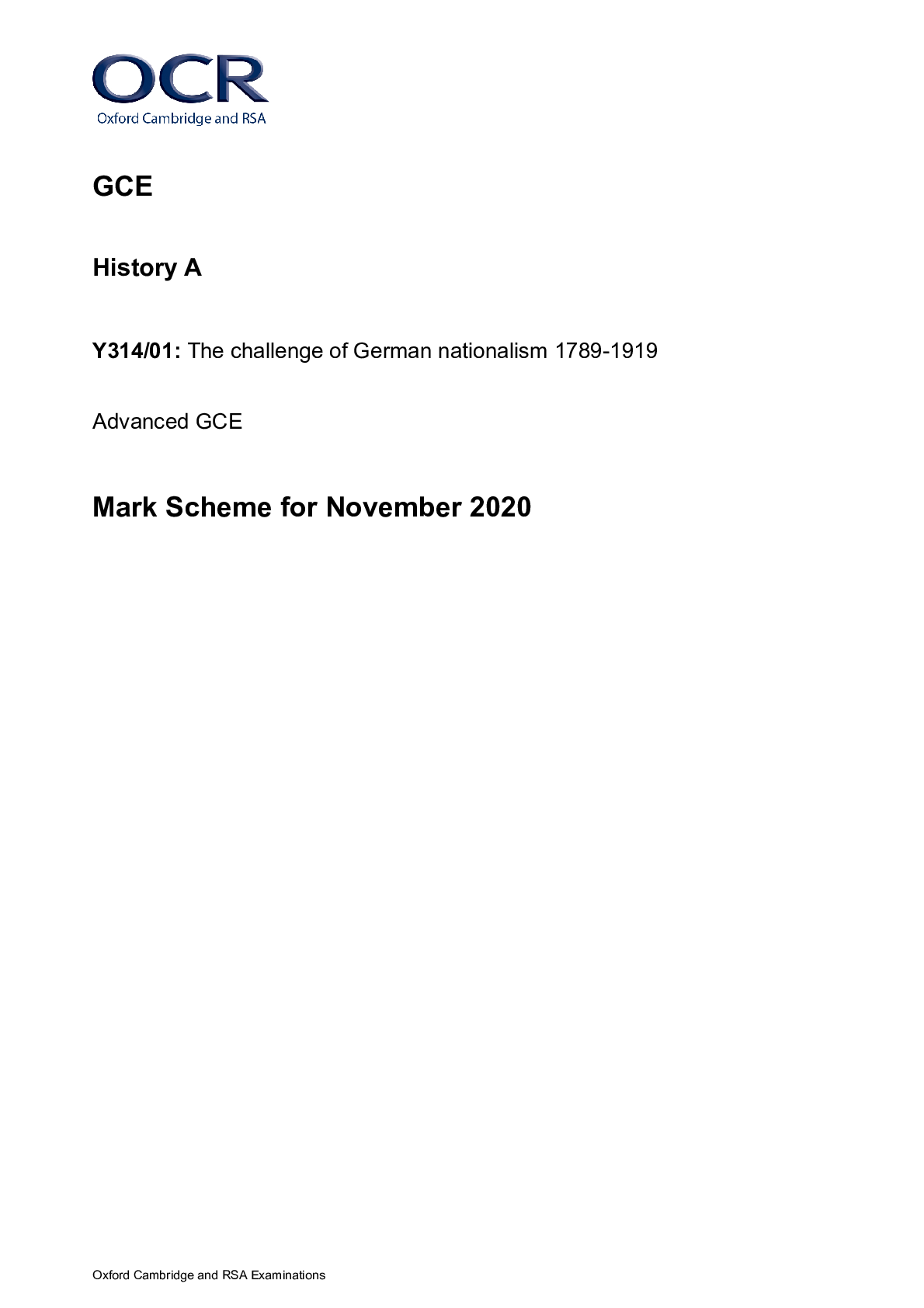
Buy this document to get the full access instantly
Instant Download Access after purchase
Buy NowInstant download
We Accept:

Reviews( 0 )
$6.50
Can't find what you want? Try our AI powered Search
Document information
Connected school, study & course
About the document
Uploaded On
Jul 17, 2022
Number of pages
12
Written in
Additional information
This document has been written for:
Uploaded
Jul 17, 2022
Downloads
0
Views
70





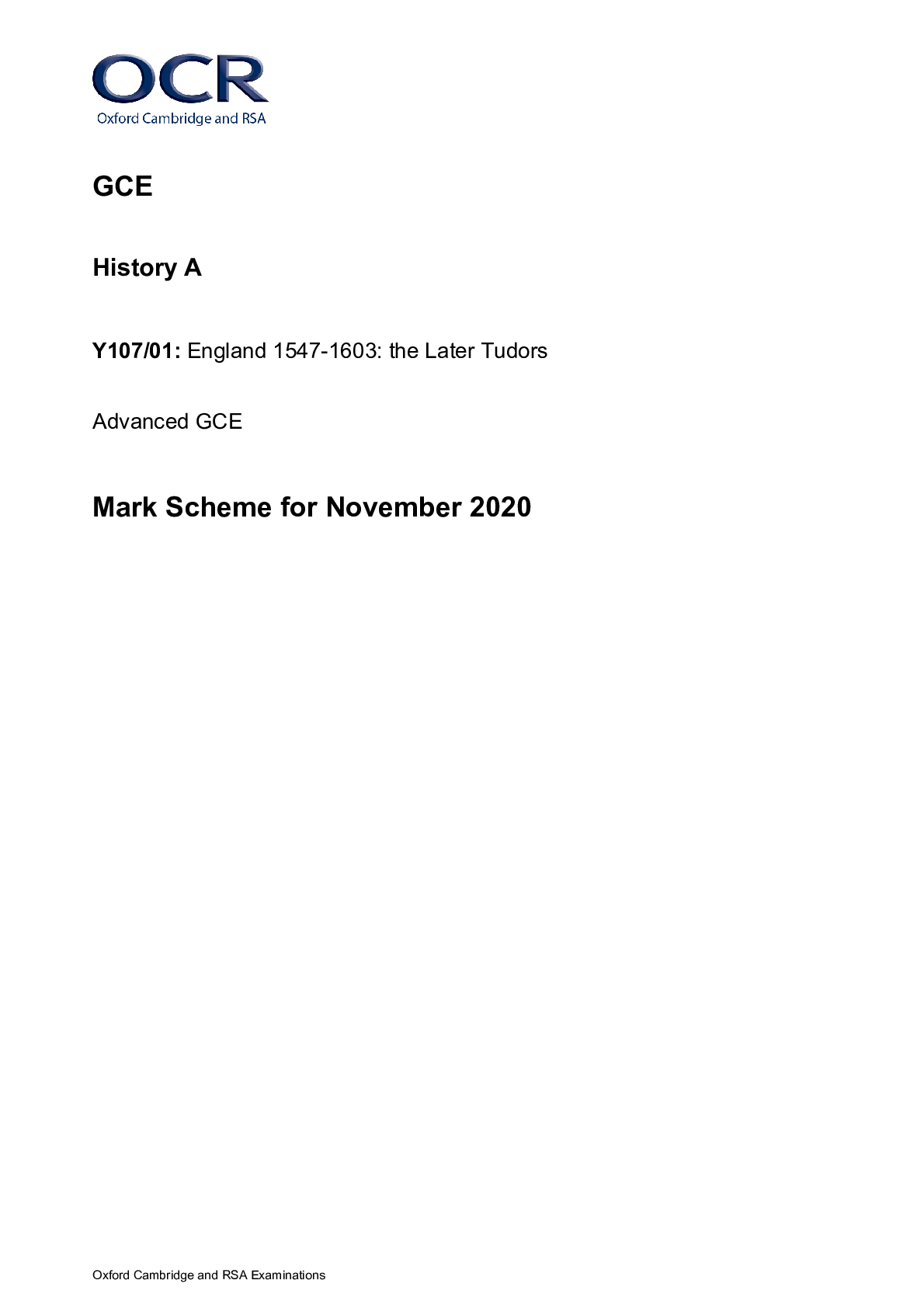
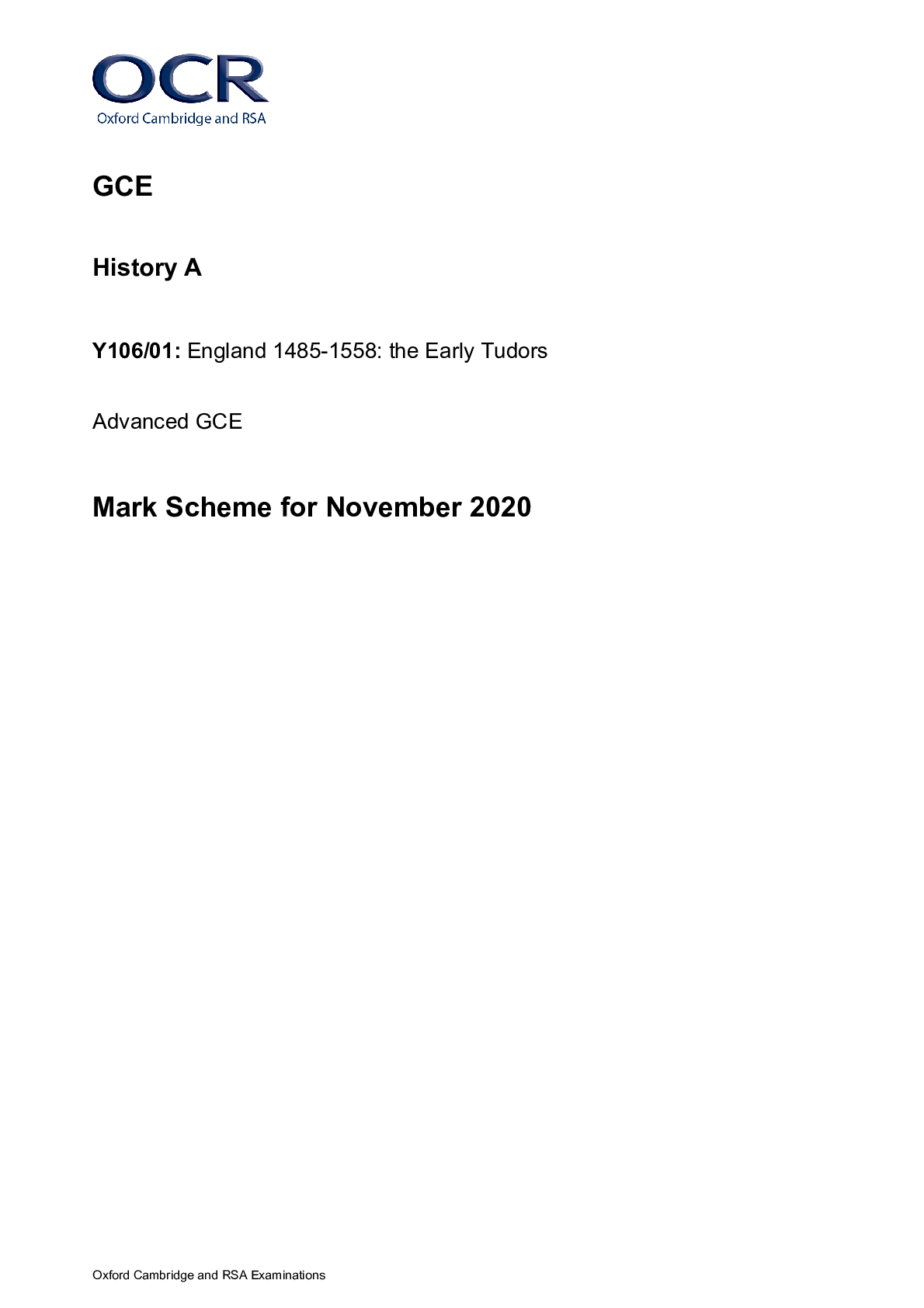
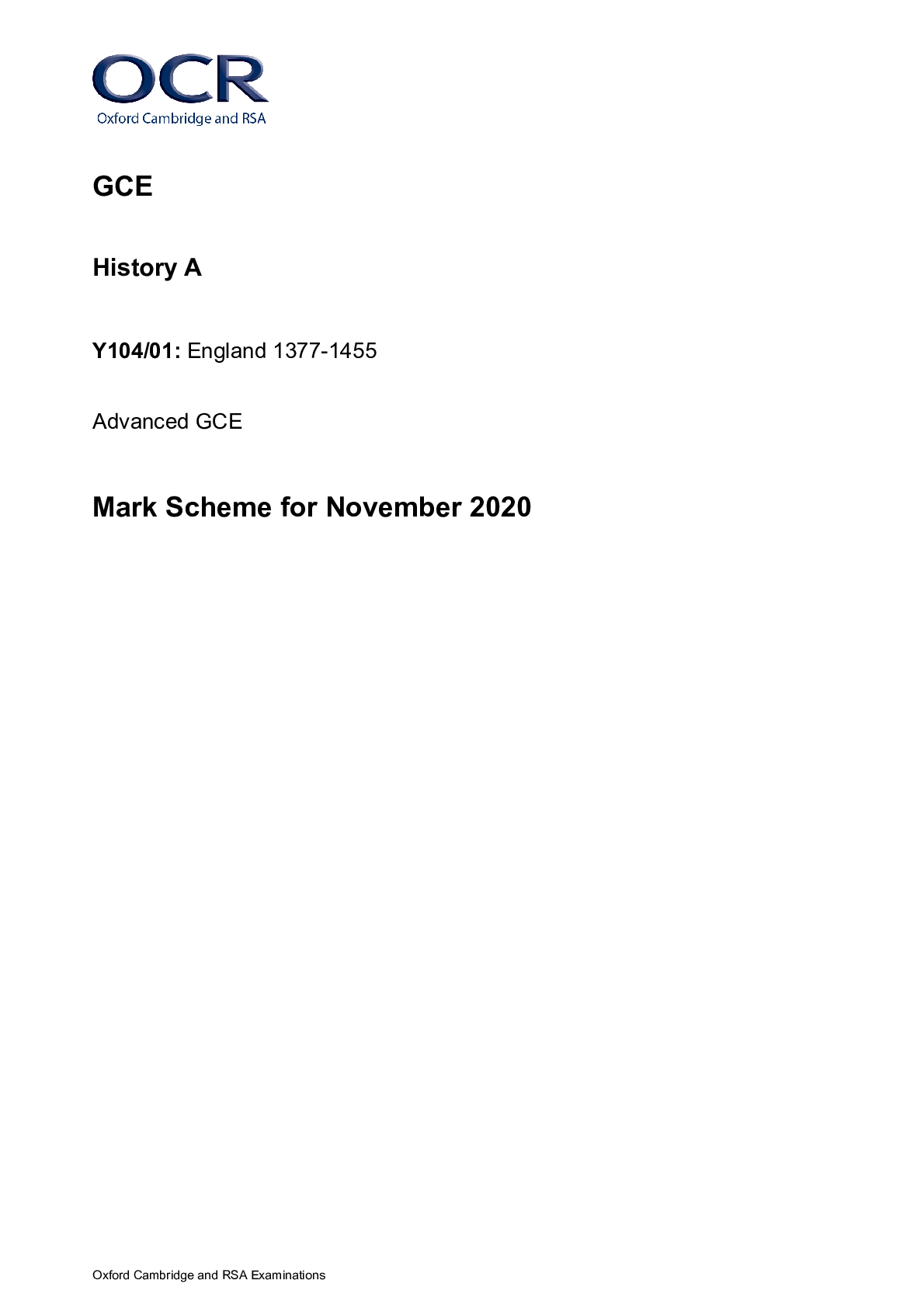
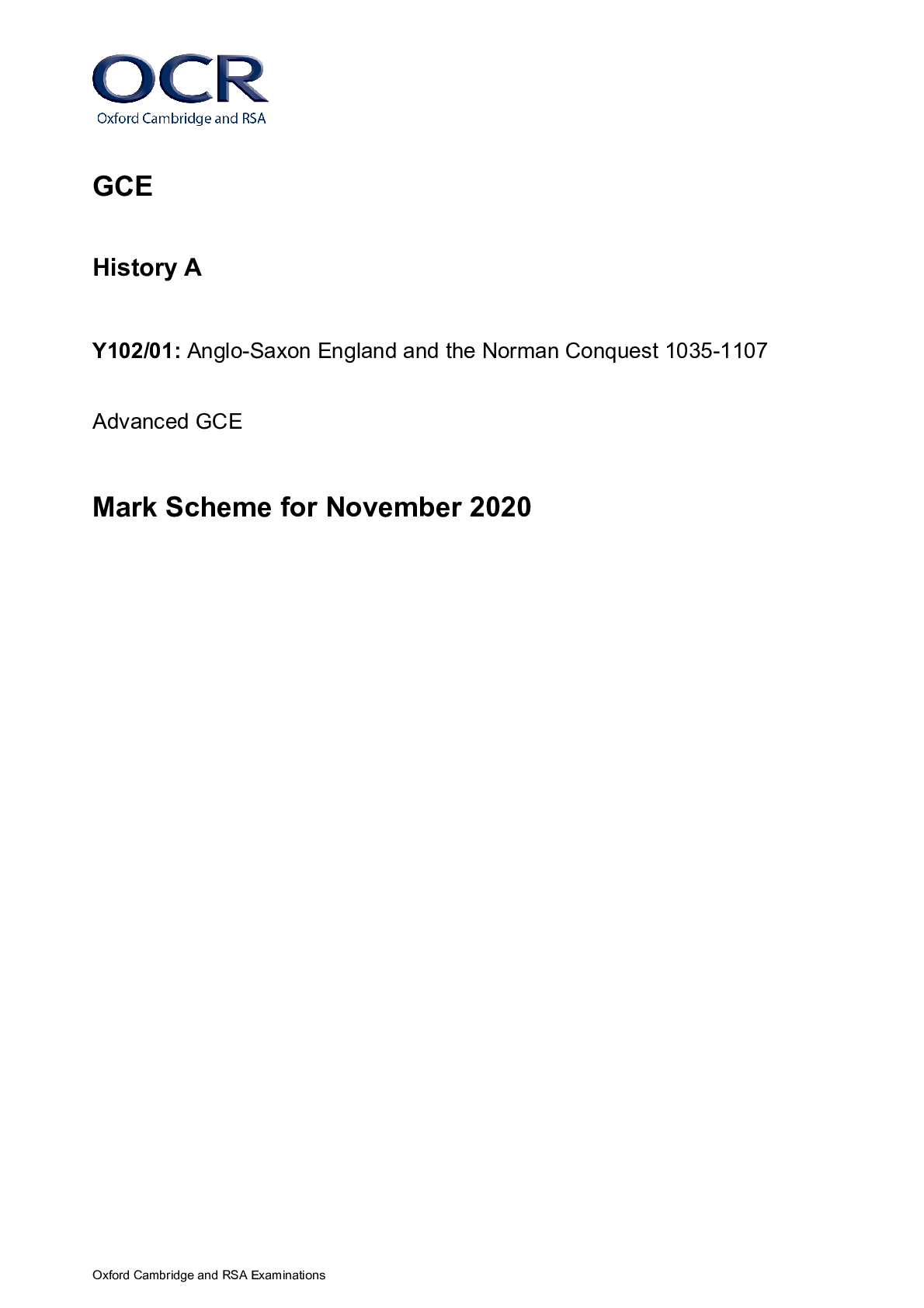
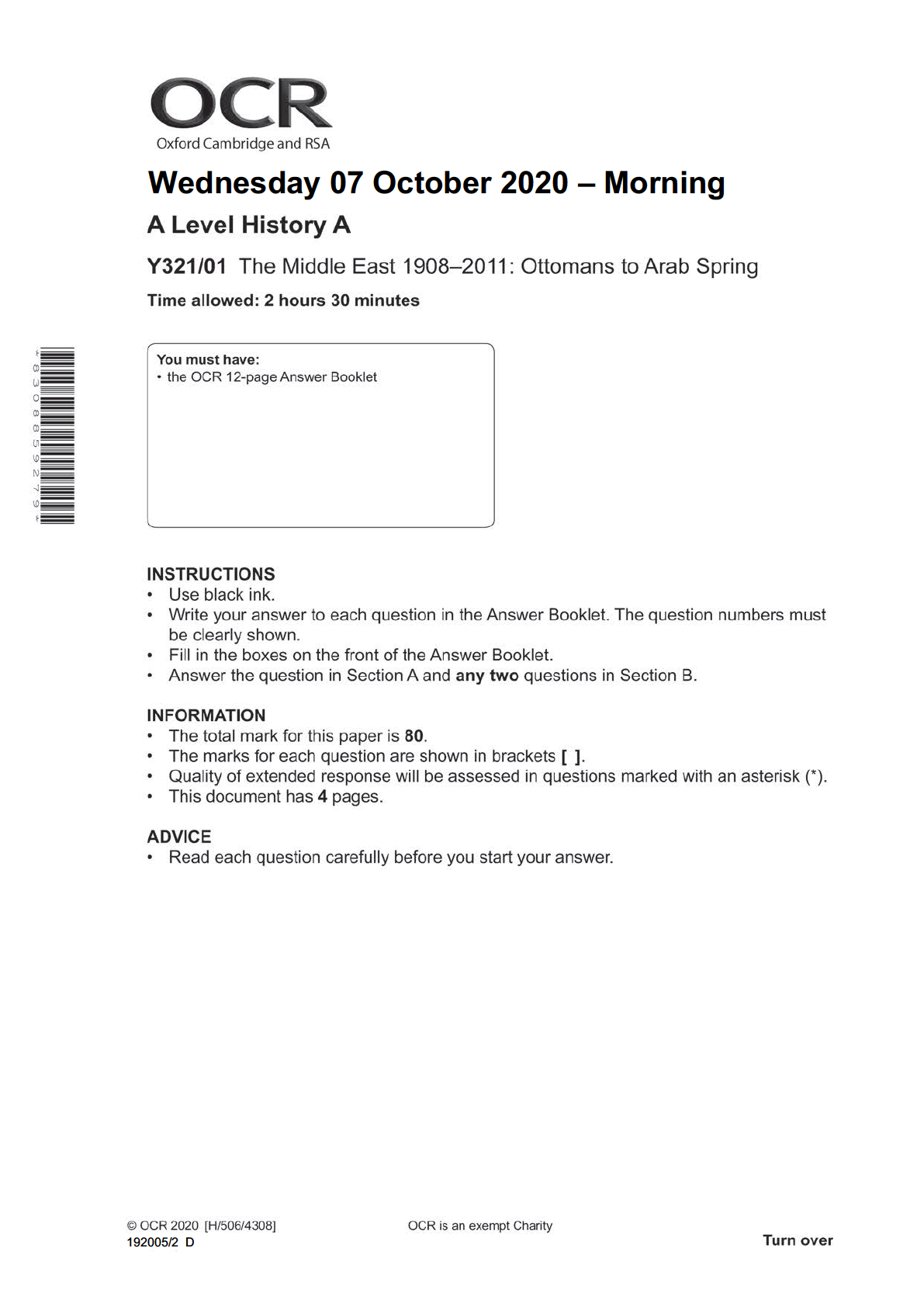
.png)

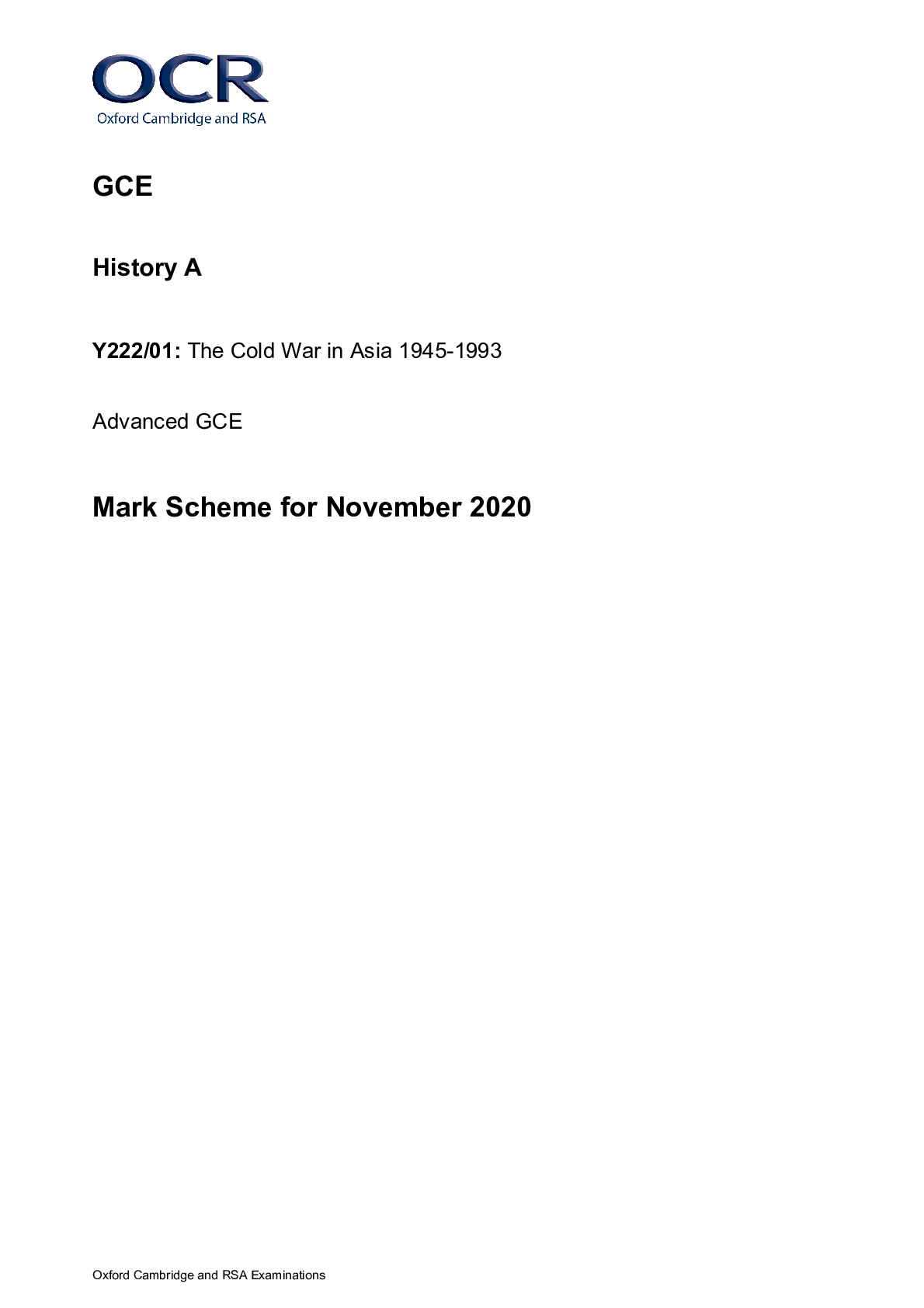



.png)









